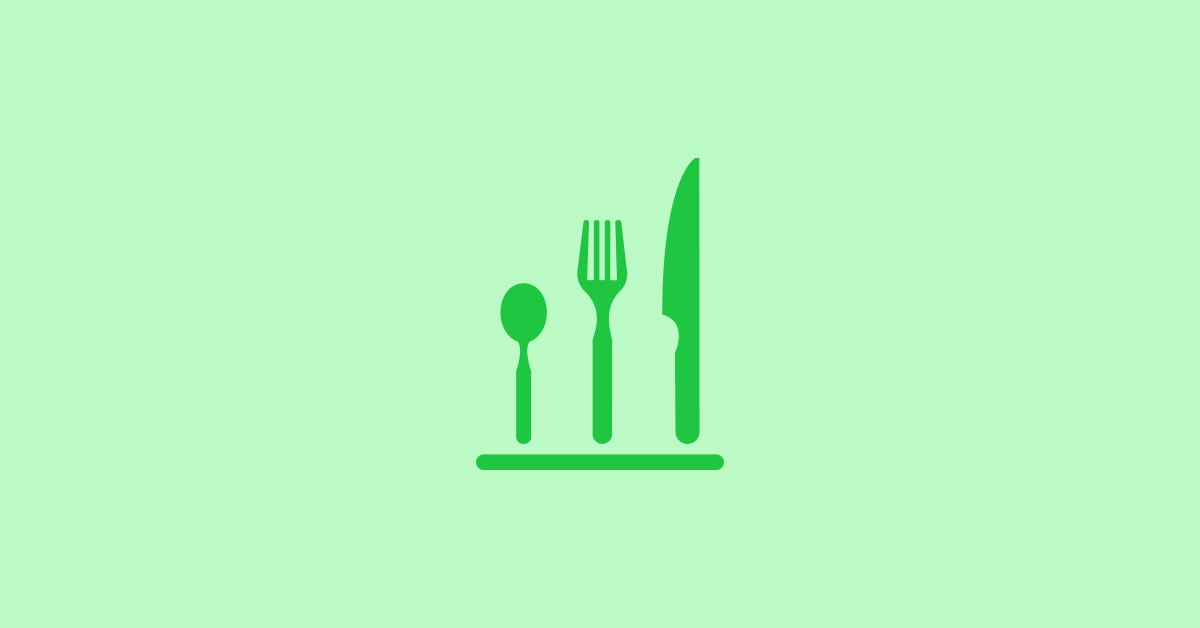
The restaurant industry is not for the faint of heart. While passion is the spark that inspires restaurateurs to pursue their dreams, profit margins determine whether or not those dreams are a sustainable business.
Unfortunately, profit margins are dwindling across the restaurant industry. Two decades ago in Australia restaurant profit margins stood at a healthy 15%. Today, profit margins across the country have shrunk to an average of 4.2%.
Alas, we’re not here to depress you with statistics about low restaurant profit margins. Instead, we’re here to help you combat this problem with a complete guide to sustainably grow profits so that your restaurant can thrive. In this guide, you’ll learn:
- What the average restaurant’s profit margins are
- How to calculate gross profit
- How to calculate net profit
- Why restaurant profit margins are so low
- How to improve restaurant profit margins
What is the average restaurant profit margin?
While there is no one-size-fits-all answer to that question, The Australian Financial Review claims that out of every $30 we spend on eating in a cafe or restaurant, the operator makes an average profit of 60c – around 2%.
Before we dive into why restaurant profitability is low and how you can improve yours, we need to distinguish between two types of profit margins: Gross profit and net profit.
What is gross profit?
Your gross profit is the difference in value between the selling price of a dish and the cost of the ingredients and materials used to make a dish (otherwise known as the cost of goods sold, or COGS).
For financially viable restaurants, gross profit hovers around 70%, meaning that for every $100 a guest spends at your establishment, $70 is gross profit.
How to calculate gross profit
To calculate your restaurant’s gross profit, you need to subtract the total cost of goods sold (COGS) for a specific time period from your total revenue (your total food, beverage, and merchandise sales).
For example, let’s say Johnny’s Burger Bar’s total sales from July to September was $1.25 million and its cost of goods sold was $400,000.
To calculate gross profit, apply this formula:

Gross profit = (1,250,000 – 400,000) / 1,250,000
Gross profit = 850,000 / 1,250,000
Gross profit = 0.68
Johnny’s Burger Bar’s gross profit as a percentage is 68%, meaning that for every $100 a guest spends at their establishment, $68 is gross profit that can be used to pay for operating expenses.
What is net profit?
Your net profit is the amount leftover from the gross profit after you deduct operating expenses like payroll, rent, utility bills, ingredients, and equipment leasing costs.
How to calculate net profit
To calculate net profit margin as for a certain time period, you need the following information:
- Sales revenue
- Gains
- Expenses
- Losses
For example, let’s say Johnny’s Burger Bar, a quick-service burger restaurant, has $1.25 million in revenue, $50,000 in gains, and $1.2 million in expenses from July to September.
Net profit = (1,250,000 + 50,000) – 1,200,000
Net profit = 100,000
How to calculate net profit percentage
To calculate net profit as a percentage, apply this formula:

Net profit as a percentage = (100,000 / 1,250,000) x 100
Net profit as a percentage = 0.08 x 100
Net profit as a percentage = 8%
Johnny’s Burger Bar’s net profit margin is 8%. For every dollar a customer spends, they’re keeping 8 cents as profit.
Why are restaurant profit margins so low?
While there are many factors that contribute to low profit margins in the restaurant industry, one of the main reasons are three major expenses commonly referred to as the “Big Three”.
- Cost of goods sold (COGS)
- Labour
- Overhead
As a general rule, one-third of a restaurant’s revenue is allocated to cost of goods sold, and another third to labour expenses. The remaining revenue must cover overhead expenses like utility bills and rent.
Once all expenses are paid, restaurants are typically left with between only 2 and 6% in net profit.
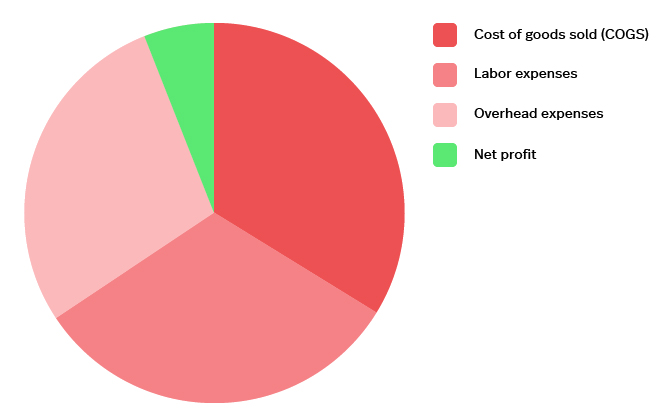
Note: COGS, labour and overhead expenses can vary greatly depending on a restaurant’s type and location. As such, there are certainly outliers (that’s to say, restaurants with revenue lower than average and restaurants with far above average profit) that impact the average. We recommend researching average profit margins for your restaurant type and setting a goal to have average-or-better profit margins year over year.
How to improve restaurant profit margins
There are two ways you can approach this problem: by increasing sales volume and by decreasing overhead expenses.
While there are many tactics that can help you increase sales volume and decrease expenses, we’ve put together our list of the most accessible ways to do so.
How to increase your restaurant’s sales
Let’s start by tackling how you can increase your restaurant’s sales volume. Here are four things you can do to achieve just that:
- Optimise your menu pricing
- Update your menu layout
- Improve your table turnover
- Adding more seating
1. Optimise your menu pricing
A simple way to increase restaurant profitability is to optimise prices on your menu. To do that, you’ll first need to know each of your dishes cost per serving and food cost percentage.
For a comprehensive breakdown of how to calculate your cost per serving, current food cost percentage, and ideal food cost percentage, read our guide to calculating food costs.
The average restaurant needs to keep food cost percentage between 28% and 35% in order to run a financially healthy operation. While this number doesn’t directly translate to profit margin, it does give you wiggle room to account for overhead expenses like labour, rent, and utilities.
If the food cost percentage of your menu items falls above the 28-35% range, you have been underpricing those items. Raise your prices so that they fall within this range.
Brian Cairns, Founder of ProStrategix Consulting, says that the biggest mistake he sees restaurant owners and operators make when it comes to menu pricing is that they don’t account for overhead expenses.
“Savvy restaurant owners and operators price each of their menu items to account for overhead expenses—that is, fixed and variable costs that aren’t associated with the meal per se. Things like utility bills, rent, and labour costs,” says Cairns.
To account for your restaurant’s overhead expenses in the price of your meals, Cairns suggests tallying up how much those expenses cost you per month and dividing that amount by the number of menu items you have.
That number is how much you could increase the cost of each menu item to cover your overhead expenses.
If you worry that increasing prices will scare customers away, you can alternatively increase restaurant profitability by decreasing food costs. Do this by finding cheaper vendors for ingredients (but don’t sacrifice quality!) or serving smaller portion sizes.
2. Update your menu layout
Also referred to as menu psychology, menu engineering is the deliberate and strategic construction of restaurant menus.
Menu engineering combines psychology, data and design to increase guest profitability. Some sources say that menu engineering can increase profits by as much as 20%.
Contrary to popular belief, menu price optimisation (what we covered above) and menu engineering are not the same. However, it’s essential to know the cost, profitability and popularity of your menu items to successfully engineer the menu.
Here’s why.
The objective of menu engineering is to assure that every item featured on your menu is popular and profitable. This assures that, no matter what guests order, it’s good for your bottom line.
Analyse your menu item sales
Start by analysing your restaurant’s sales reports for a specific timeframe. You want to find which menu item’s:
- Sell the most
- Sell the least
- Highest profit
- Lowest profit
If you’re using Lightspeed, you can find all that information in your Sales By Report. Follow these steps to access the report:
- From Lightspeed’s Restaurant POS back office, click Reports.
- Select Sales By Reports.
- Set the date range you want to pull sales data for in the top right corner.
- Filter the list by Quantity and Profit.
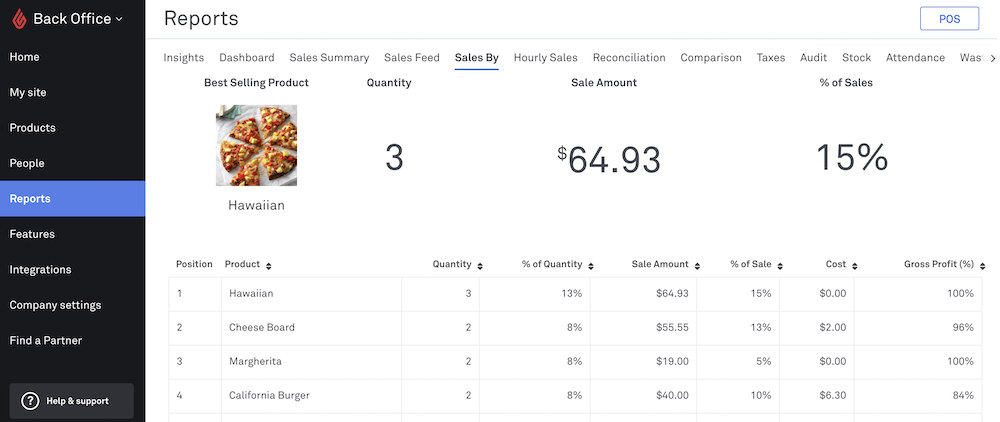
Create a menu matrix
Next, categorise your menu items into four categories:
- Stars: High-profit, popular menu items.
- Cash cows: Low profit, popular menu items.
- Puzzles: High-profit, low popularity menu items.
- Dogs/Duds: Low-profit, low popularity menu items.
We call this a menu matrix. Here’s what it should look like once you’re done.

A menu matrix helps you visualise which dishes are most important for your restaurant’s revenue.
Your goal is to use your menu matrix to inform your menu design and draw as much attention as possible to your stars, cash cows, and puzzles since they’re your most popular, high-profit dishes.
Consider phasing out unpopular, low-profit items from your menu to keep your guest’s focus exclusively on high-profit items.
Update your menu layout
There are plenty of design tricks menu engineers use to draw attention to high-profit dishes. In fact, applying menu engineering design tricks can increase the sales of an item by up to 30%.
We’ve listed all the best menu engineering and design tricks in our Ultimate Guide to Restaurant Menu Design. Check it out for an A to Z walkthrough.
3. Improve your table turnover
Table turnover is the timeframe that a guest occupies a table at your restaurant from their arrival to departure. The more customers you serve per service, the more revenues you’re positioned to make.
If you want to maximise your revenues per service, your ultimate goal is to reduce the time a guest occupies a table (without making guests feel rushed) and maximise how much they spend.
It’s a delicate balance, to be sure. Serve a customer too slow and you’re missing out on serving a higher volume of customers. Serve a customer too fast and you risk making them feel rushed and unappreciated.
The best way to speed up your table turnover and serve more customers per service is to equip your restaurant’s front of house (FOH) and back of house (BOH) staff with tools that speed up their workflows.
Seat guests faster
Seating your guests faster is the first step to serving more guests per service.
Depending on your restaurant type, your host is the first touchpoint a guest has once they arrive at your establishment. The last thing you want is for there to be a bottleneck at the front door.
To prevent this from happening, Lightspeed developed an intuitive, adjustable floor plan that enables hosts to know in real-time which tables are free, check-in reservations, and seat guests more efficiently.
Serve guests faster
Serving your guests faster is dependent on whether or not your kitchen and wait staff are in sync.
With Lightspeed, wait staff can reduce food wait times by using it’s built-in tableside ordering feature, along with a kitchen display system (KDS).
Rather than writing down the orders of the tables they’re serving on a paper and manually sending each of them to the kitchen, tableside ordering enables wait staff to take orders directly at a guest’s table and send them immediately to the appropriate kitchen workstation.
For instance, if a guest orders a cocktail and an entree, both orders are automatically filtered by type (cocktail + entree) and sent to the bartender and cook’s kitchen display system.
The kitchen display system organises orders chronologically, colour-codes them and even has audible alerts for new incoming orders. All of these features make it easy for kitchen staff to get orders ready faster.
Once an order is ready to be run to a table, kitchen staff can simply send that table’s waiter a notification. The result is less back-and-forth between the front and back of house, faster service and faster table turnover.
Process payments faster
The final step to improving table turnover is by processing payments faster. To do that, Lightspeed’s adjustable floor plan features colour indicators that let wait staff know which stage of their meal a table is at.
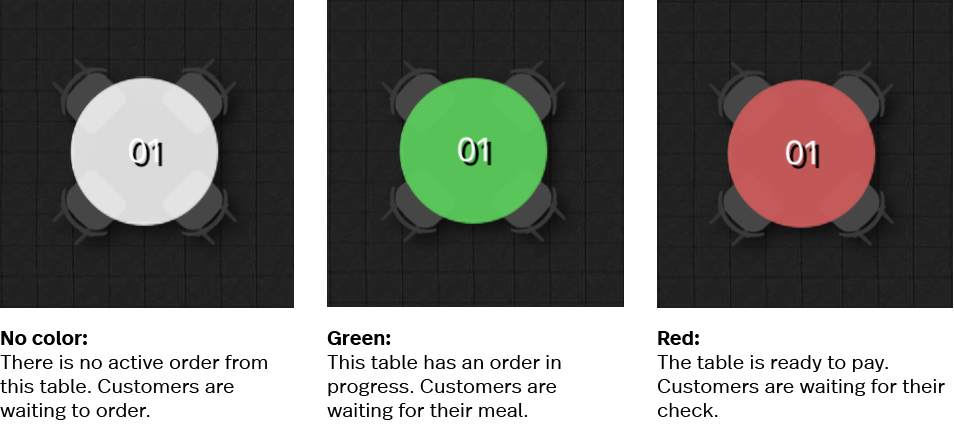
Rather than ask whether or not a guest is ready to pay (and risk making them feel rushed), wait staff can know before approaching the table.
Equipped with that information, wait staff can approach a table when it’s marked as ready to pay, split the check however the guests want and accept payments right from their table.
Customers appreciate the efficient service and owners, operators and managers appreciate turning their tables faster.
4. Add more seating
If your restaurant is fully booked every service (and if you have enough available square footage in your dining room), you could consider adding additional seating or tables. This is a quick way to increase the volume of customers you serve per service.
If you optimised your menu pricing and design like we mentioned earlier, you can also substantially increase your sales per service.
Before you add tables to your restaurant floor plan, you first need to consider your guest’s comfort level, restaurant type and industry standards for square footage per guest.
Average square meterage per guest
- Fine dining: 1.7 to 1.9 square metre
- Full-service dining: 1.1 to 1.4 square metre
- Counter service: 1.7 to 1.9 square metre
- Fast food dining: 1 to 1.3 square metre
To add more seats to existing tables in your Lightspeed floor plan, follow these steps.
- Choose the floor you want to edit In Lightspeed Restaurant.
- Select Edit from the left menu of the Tables screen. A new settings panel will appear.
- Select the Chairs icon. Drag and drop chairs onto your table plan.
- Select Save > Yes to finalise your changes.
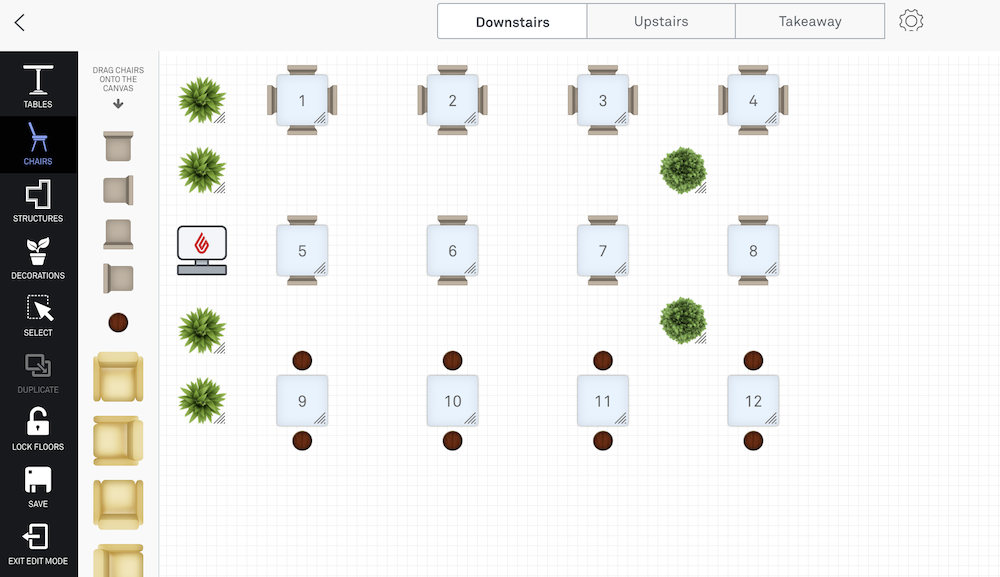
When you can seat more guests, or take larger parties thanks to extra seating, you’ll make more money with the same overhead.
How to decrease overhead expenses
The next way to improve your restaurant profitability is by reducing ongoing expenses like labour and utilities.
- Improve your employee scheduling
- Reduce food waste
- Lower utility bills
1. Improve your employee scheduling
How do you currently decide how many servers to schedule per service and which servers to schedule?
To reduce labour costs while maximising your revenue per service, we suggest leveraging your restaurant’s sales and employee data.
Schedule too many servers during slow business hours and you risk spending too much on labour costs. Schedule too few servers and you risk turning tables slower, spreading your staff thin and weakening the quality of your customer experience.
Your goal when planning your employee schedule is to assure that your restaurant is sufficiently staffed to meet customer demand at any time of the day.
With Lightspeed’s Restaurant POS analytics you can clearly identify which of your servers generate the most revenue, as well as your restaurant’s busiest and slowest business hours.
Equipped with that information, you can schedule your top-selling servers during your busiest business hours, maximise your revenue per service and minimise your labour costs.
With restaurants spending about 40% of their monthly revenue on labour (the largest operating expense only second to cost of goods sold), optimising your employee scheduling is an excellent and easily-accessible way to increase revenues and decrease ongoing expenses.
2. Reduce food waste
In Australia over 5.3 million tonnes of food that is intended for human consumption is wasted each year – costing the economy over $20 billion.
Remember, approximately one-third of a restaurant’s revenue is allocated to cost of goods sold (COGS). If you end up throwing that food away, you’re effectively losing money that could have been profit or used to cover other expenses.
The World Resources Institute found that for every $1 a restaurant invests in reducing food waste, they save an average of $7. That type of return on investment is certainly something you should consider if your goal is to improve your profit margins.
3. Lower utility bills
Did you know that restaurants consume an average of five to seven times more energy per square foot than other commercial buildings? For quick-service restaurants and other high-sales volume establishments, it’s up to ten times more.
And that consumption adds up to higher utility bills.
Tim Powell, Managing Principal at food service management consulting firm Foodservice IP, says that fixed costs like utility bills account for up to 33% of a restaurant’s sales.
Investing in eco-friendly kitchen appliances and lighting can contribute to lower utility bills, which leaves more revenue from sales left in the bank.
The Australian Government’s Energy Rating system can help you cut down on how much energy your restaurant uses. While the initial cost of the investment may feel steep, the long-term savings on your utility costs more than account for it.
The benefits of eco-friendly appliances
- Consume less energy
- Lower utility bills
- High return on investment
Businesses that actively reduce their food waste and environmental footprint typically have margins 3.3% higher than businesses that don’t. If you want to learn more on this topic, check out our blog How Reducing Your Environmental Footprint Yields Huge ROI where we dive deeper into the financial benefits of eco-friendly business practices.
Top takeaways for improving restaurant profit margins
The restaurant industry is a tough business to succeed in.
Use the tips we covered here to increase your sales volume, decreasing your expenses and grow your profit margins. In summary, our tips were:
- Optimise your menu pricing so that each dish you serve is beneficial to your bottom line.
- Update your menu layout to sell more of your most profitable dishes.
- Improve your table turnover and serve more guests per service.
- Adding more seating to increase revenue per service.
- Improve your employee scheduling to both reduce labour expenses and maximise sales per service.
- Reduce your food waste and environmental footprint to save on COGS and utility bills.
While there’s no one-size-fits-all solution for increasing your restaurant profitability, the above tactics are tried and true ways to do so. Try to apply them to your establishment and you’ll be in a great position to stay in the black year after year.
Want to learn more? Our free resources on How to Keep Cogs Low and Margins High and Profit and Loss Template are here to help.

News you care about. Tips you can use.
Everything your business needs to grow, delivered straight to your inbox.


